The transmitted light technique was used to visualize multi-phase flow in macro-heterogeneous sand packs. Our goals were to observe non-wetting phase (oils) infiltration and redistribution in water saturated sand and then study remediation techniques. We used a small (1-foot x 2-feet) chamber for technical development and then built a larger (2-feet x 2-feet) chamber for remediation experiments.
Here is more background on the DNAPL Lab.
Soltrol 130 Experiments
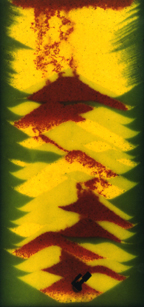
Three experiments were performed in a 1×2 foot chamber using the relatively innocuous, lighter than water NAPLs Soltrol-220 and Soltrol-130. We used these experiments to develop our techniques. In this photo the red dyed Soltrol was injected at the bottom of the macro-heterogeneous sand pack and it percolated upward. The experiment ended when the Soltrol reached the top of the chamber. Non-wetting phase redistribution over time led to the build up of Soltrol at the top of the chamber.
TCE-1 Experiment
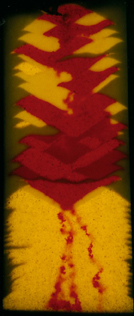
This sand pack was constructed with a 50-70 sand barrier that blocked the infiltration of the non-wetting Trichloroethylen (TCE) and caused the TCE to backfill a major portion of the 12-20 and 30-40 sand. It was very interesting overall. We also tried to run the TCE infiltration at a lower flow rate than previously, 0.5 ml/min, but because this was our first experiment with TCE we didn’t have the proper hardware and ended up melting flow fittings during the test. For this reason there were multiple flow rates in this test and several pauses, while we replaced fittings and refilled lines.
For More Information
Glass, R.J., S.H. Conrad, and W. Peplinski, Gravity destabilized non-wetting phase invasion in macroheterogneous porous media: Experimental observations of invasion dynamics and scale analysis, Water Resources Research, 36:11:3121-3137, 2000.
TCE-2 Experiment
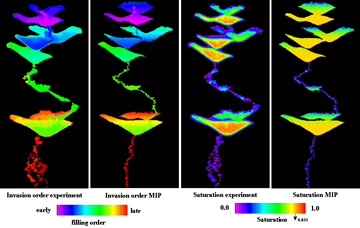
In this experiment we spent a considerable amount of time perfecting our method of CO2 delivery to the chamber so that we could measure pressure and flow rate. Flow rate varies constantly with pressure so rates were recorded using a video camera. Pressure was measured with a transducer and recorded digitally. We perfected the grain alignment processing technique on these tests so the digital images are in very nice condition. A major part of these tests was the “throbbing analyses” which quantified the pulsing of CO2 as it passed through capillary barriers in the 30-40 sand. We finished the test by injecting TCE into the pack and observing its redistribution.
For More Information
Glass, R.J, and L. Yarrington, Mechanistic modeling of fingering, nonmonotonicity, fragmentation, and pulsation within gravity/buoyant destabilized two-phase/unsaturated flow, Water Resources Research, 39(3), 1058, doi:10.1029/2002WR001542, 2003.
TCE-3 Experiment
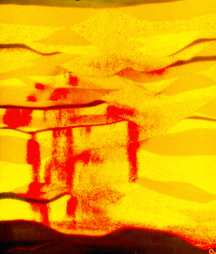
This was the first experiment in the new 2×2 foot chamber. It was done to look at behavior of TCE in the presence of MA-80I surfactant. The surfactant flood mobilized the TCE rather than simply dissolving it. Most of the TCE fell to the bottom of the chamber, out of sight in the 50-70 sand. Dissolution proceeded from that point but we got very small recoveries, as shown by the gas chromatograph data, because most of the TCE was out of the main flow field.
TCE-4 Experiment
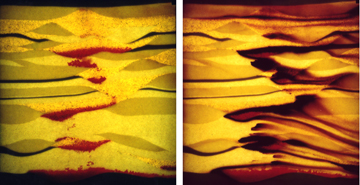
Tween-80 surfactant did a better job of dissolving the TCE without mobilizatron but it seems rather thick and gooey if it comes in contact with air. On this test we got much better recovery based on GC data as well as visual inspection. A small pool was left at the very bottom of the chamber where the flow field just skimmed the top of the TCE. Further experimentation in this sand pack included Partitioning Tracer Test and then a short flood of Potassium Permanganate, shown at left, to observe its remediation qualities.
For More Information
Conrad, S.A., R.J. Glass, and W. Peplinski, DNAPL remediation experiments in macro-heterogeneous sand, Journal of Contaminant Hydrology, 58, 13-49, 2002.
Other Experiments
Other experiments conducted in the DNAPL Lab or related to this work are described in these publications.
Ji, S.H., I.W. Yeo, K.K. Lee, and R.J. Glass, Influence of ambient groundwater flow on DNAPL migration in a fracture network: Experiments and simulations, Geophysical Research Letters, 30(10), 1504, doi:10.1029/2003GL017064, 2003.
Detwiler R., H. Rajaram, and R.J. Glass, Nonaqueous-phase liquid dissolution in variable-aperture fractures: Development of a depth-averaged computational model and comparison to a physical experiment, Water Resources Research, 37:12:3115-3129, 2001.